12.1 Home Tab
The Home tab provides a dashboard of File Dynamics component summaries, statistics, access to Engine services settings, and more.
12.1.1 Status
This displays a dashboard summarizing the status of the product license, the Event Monitor and Agents, if the Work Log is configured, the last time the GSR Collector was run, and graphic summaries of policy and jobs in the queue. You can resize and rearrange the presentation to your preferences.
Figure 12-1 The Status Page
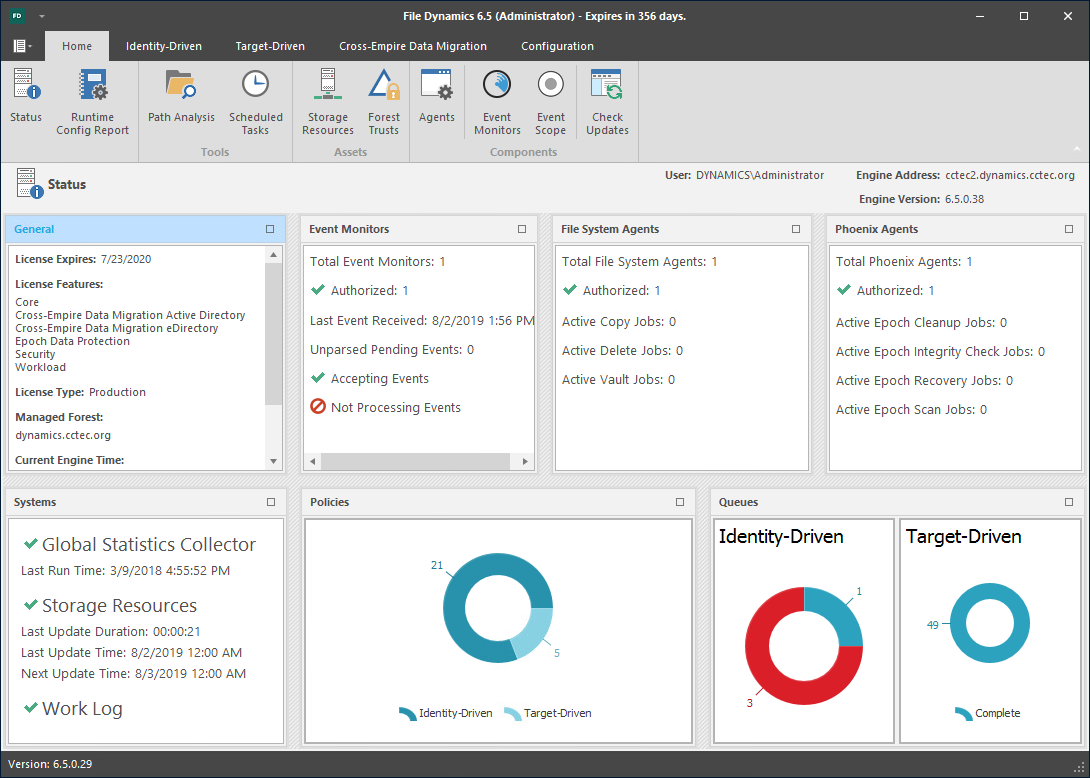
12.1.2 Runtime Config Report
Runtime Config reports are used to build reports on the current configuration and pending events from the Engine. You can indicate which configuration data you want included in the report by selecting the desired check boxes.
Figure 12-2 Runtime Config Report
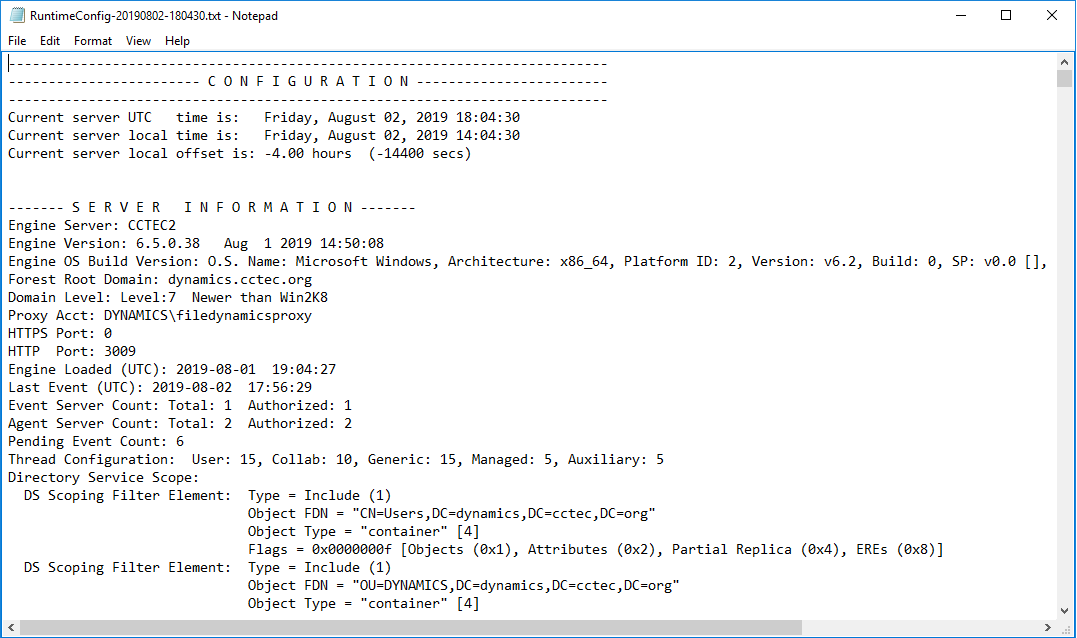
12.1.3 Path Analysis
The Path Analysis page shows a tree view of your network storage and provides various storage reports. These reports are a quick way to determine the trustees of a share or folder, the number of files and file types in a given folder, whether a quota is assigned to a folder and if so, how much, and the permissions assigned to individual files.
NOTE:Whether managed by File Dynamics or not, all of the storage visible in the left panel is eligible for path analysis.
Use the left pane to browse and select network shares and folders. Use the right pane to view the files within a selected folder.
Clicking a share or folder in the left pane activates the toolbar. The toolbar has the following options:
Information: Lets you view a variety of information pertaining to a selected share or folder.
-
Quota: Specifies if quota is set for a folder, the quota size, and the amount of free space remaining in the folder.
-
File Types: Categorizes the content of the selected folder by displaying the various file types, the total number of each file type, and the total size of each file type. For example, to know if a user is storing non-work related files in his or her home folder and the total size of these files, you could use this feature to quickly determine this information.
-
Permissions: Opens the View Permissions dialog box, which lists all users and objects that have any type of rights to the selected share, folder, or file. The View Permissions dialog box also indicates the permissions that each of these users and objects have as well as how these rights are obtained.
Tools: Lets you create, rename, and delete folders within the network file system.
Rebuild: Rebuilds your storage resource list. You might need to do this to display the storage resource list structure after it has been modified.
Refresh: Refreshes the view within the Path Analysis page.
File Permissions: This opens a dialog box displaying all the objects that have permissions to a selected folder, the specific permissions, and how those permissions were obtained.
Filter: This lets you filter the view of the subfolders for a specified folder.
12.1.4 Scheduled Tasks
Use the Scheduled Tasks page to schedule storage resources discoveries and database cleanup tasks as well as schedule Groom policies.
Schedule a Storage Resources Discovery
This task initiates a search within the entire forest domain for any new shares or DFS namespaces. Depending on the size, configuration, and topology of your network, this can take a significant amount of time.
-
In the Admin Client, click the Engine tab.
-
Click Scheduled Tasks.
-
From the list of scheduled tasks, double-click Storage Resources Discovery.
-
In the Schedule Start region, set the time and data parameters when you want the storage resources discovery to take place.
-
In the Schedule Recurrence region, specify the frequency of the storage resources discovery.
-
Click OK.
Run a Storage Resources Discovery
In addition to scheduling a storage resources discovery, you can run the storage resources discovery immediately.
-
In the Admin Client, click the Engine tab.
-
Click Scheduled Tasks.
-
From the list of scheduled tasks, right-click Storage Resources Discovery and select Run.
-
Click Yes in the confirmation dialog box.
Schedule a Database Cleanup
A database cleanup reduces database bloat that can affect File Dynamics performance. A database cleanup does the following:
-
Removes old scan entries
-
Removes deleted path history entries
-
Removes deleted object entries
-
Removes events that are marked as completed
-
Cleans up DS objects based on their delete time
-
Removes orphaned action blocks
While the database cleanup is in process, event processing is turned off. Once the cleanup finishes, event processing is turned on.
-
In the Admin Client, click the Engine tab.
-
Click Scheduled Tasks.
-
From the list of scheduled tasks, double-click Database Cleanup.
-
In the Schedule Start region, set the time and data parameters when you want the database cleanup to take place.
-
In the Schedule Recurrence region, specify the frequency of the database cleanup.
-
Click OK.
Run a Database Cleanup
In addition to scheduling a database cleanup, you can run a database cleanup immediately.
-
In the Admin Client, click the Engine tab.
-
Click Scheduled Tasks.
-
From the list of scheduled tasks, right-click Database Cleanup and select Run.
-
Click Yes in the confirmation dialog box.
Schedule a Groom Policy
-
In the Admin Client, click the Engine tab.
-
Click Scheduled Tasks.
-
Click Add.

-
From the Task Name drop-down menu, select Policy-based Groom.
-
Click Options to access the Take Action dialog box.
-
Enter the settings in the dialog box and click OK.
-
In the Description field, enter a description of the scheduled groom.
-
In the Schedule Start region, set the time and data parameters when you want the scheduled groom to take place.
-
In the Schedule Recurrence region, specify the frequency of the scheduled groom.
-
Click OK.
12.1.5 Storage Resources
This page lets you rebuild the storage resource cache used in File Dynamics. Because File Dynamics uses the storage resource cache to accelerate operations, there might be times when you need to use this page to populate the cache with new shares.
To prevent burdening the File Dynamics Engine in listing or rebuilding all storage devices and shares in the Active Directory forest or domain, you can “scope” the containers of the forest or domain for storage devices and shares to be included or excluded as managed storage resources.
Figure 12-3 Storage Resources Page
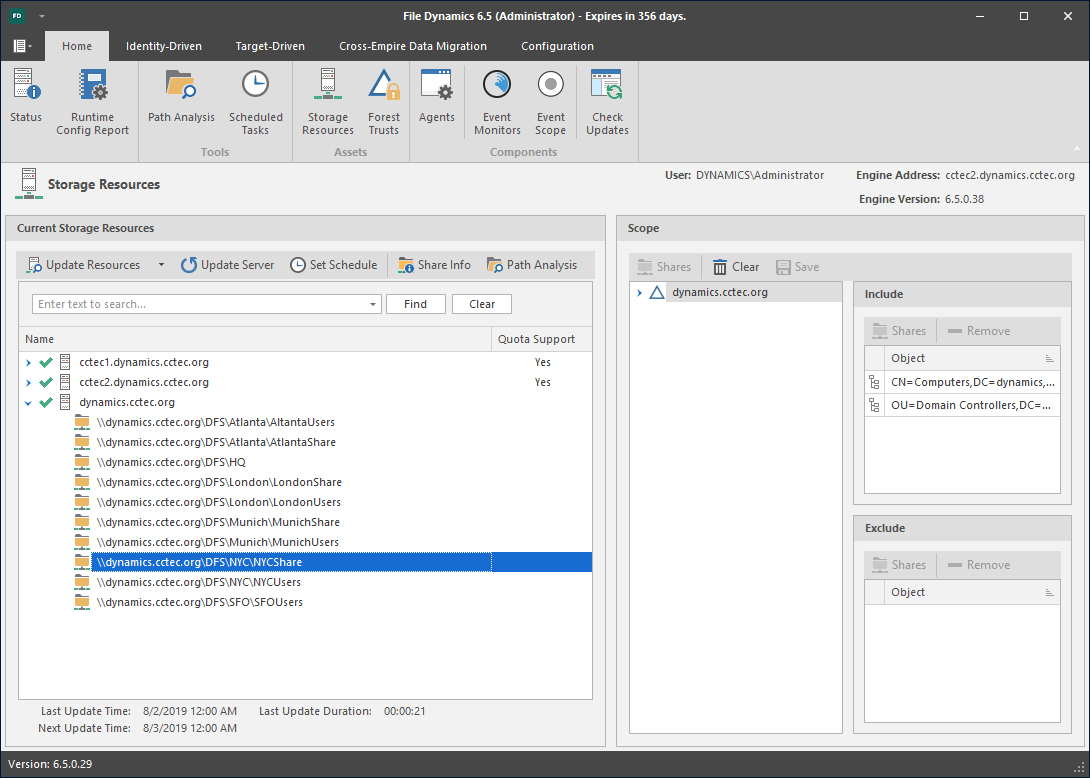
Current Storage Resources: This region displays storage resources while providing tools for performing actions pertaining to these storage resources.
Update Resources: Clicking this button initiates a search within the specified scope for all available shares or DFS namespaces. When you create or edit a policy, you might need to rebuild the list if the share or DFS namespace you need does not appear in the storage resource list. Depending on the size, configuration, and topology of your network, this can take a significant amount of time.
Clear Resources: Available from the Update Resources drop-down menu, this option clears the current storage resource list so that it can be completely rebuilt when issues arise.
Set Schedule: Allows you to set the schedule for rebuilding the storage resource cache.
Share Info: Selecting a share and then clicking this button opens the Server Share Properties dialog box which displays the permissions and Local Security Authority (LSA) settings for the share. The details provided in the Server Share Properties are useful when working with a Micro Focus Support representative.
NOTE:Share Info requires elevated privileges.
Path Analysis: Clicking this button opens the Path Analysis page for the selected share, allowing you to browse it and do path analysis on any folder you select.
Scope: This region lets you specify the scope within Active Directory and the network file system of the containers and servers to include and exclude. Based on the specified scope, the available shares will be displayed in the Storage Resource list.
Shares: When you expand a container object and select a server, you can click Shares to view details about the shares located on that server. Clicking Shares opens the Server Shares Properties dialog box where you can view the permissions and Local Security Authority (LSA) settings for each share. The details provided in the Server Share Properties are useful when working with a Micro Focus Support representative.
Clear: Clicking this removes any object located in the Include and Exclude lists.
Save: Saves the scope settings.
Remove: Removes objects located in the corresponding Include or Exclude lists.
Last Rebuild Time: Displays the last date and time that the storage resource list was rebuilt.
Last Rebuild Duration: Displays the length of time it took to generate the new storage resource list.
Next Rebuild Time: Displays the date and time when File Dynamics next rebuilds the storage resource list. Unless rebuilt through the Rebuild button, the storage resource list is rebuilt automatically at midnight each day.
Displaying Windows Server Clusters
If a Windows Cluster File Server Resource is not displayed in the Storage Resource List, verify that the Description field of the cluster file server resource includes the words cluster and virtual. If these two words are not included in the description, File Dynamics cannot see it as a storage resource.

Once you modify the description in the Description field, you can perform a storage resources discovery from the Scheduled Tasks page to add the resource to the Storage Resource List. For more information, see Run a Storage Resources Discovery.
12.1.6 Forest Trusts
Forest trust relationships provide security across multiple Active Directory forests. Before you can authenticate across trusts and migrate folders from one forest to another, Windows must first establish a trust path between the forests.
Overview
File Dynamics has limited support for forest trusts for Active Directory to Active Directory Cross-Empire Data Migration and for managing storage resources in another forest. The trust cannot be leveraged to monitor for events in another forest.
To configure a supported forest trust, see Configuring a Forest Trust. After a forest trust is configured for use, you will need to set the appropriate permissions on shares so that they can be made available for access and management.
After a supported forest trust is established, the Admin Client can be used to enable it for use. Multiple forest trusts can be established and configured for use.
Table 12-1 Supported Trusts
|
Trust Type |
Direction |
Scope of Authentication |
Supported |
|---|---|---|---|
|
External |
One-way or two-way |
Selective or Forest-wide |
No |
|
Realm |
One-way or two-way |
Selective or Forest-wide |
No |
|
Forest |
One-way or two-way |
Selective |
No |
|
Forest |
One-way incoming or two-way |
Forest-wide |
Yes |
|
Shortcut |
One-way or two-way |
Selective |
No |
Active Directory Cross-Empire Data Migration Trust Scenarios
One-way Incoming
In this scenario, a one-way incoming trust has been established between Forest A and Forest B. Here, File Dynamics will copy data and permissions from storage resources in Forest B to Forest A.
Figure 12-4 One-way: Incoming Forest Trust

Two-way
In this scenario, a two-way trust has been established between Forest A and Forest B. Here, File Dynamics will copy data and permissions from storage resources in Forest B to Forest A.
Figure 12-5 Two-way Forest Trust

Trusted Resource Management Scenario
In this scenario, a one-way incoming trust has been established between Forest A and Forest B. Here, File Dynamics will monitor for events in Forest A account forest and manage data in the Forest B resource forest.
Figure 12-6 One-way: Incoming Trust

For more information on Active Directory Domains and Trusts, see https://technet.microsoft.com/en-us/library/cc770299.aspx.
Configuring a Forest Trust
-
On a server in the target forest in which File Dynamics is installed, open Active Directory Domains and Trusts.
-
Right-click the target forest in which File Dynamics is installed and click Properties.
-
In the properties dialog box, click New Trust.
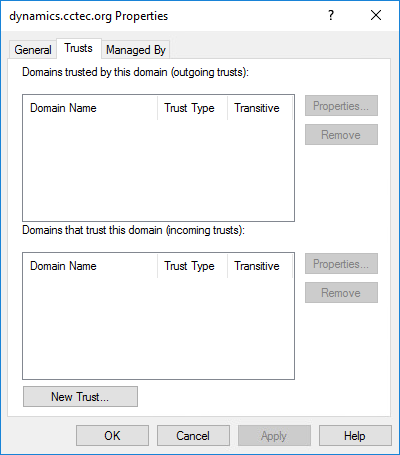
-
In the New Trust Wizard dialog box, enter the DNS name for the incoming forest trust and click Next.
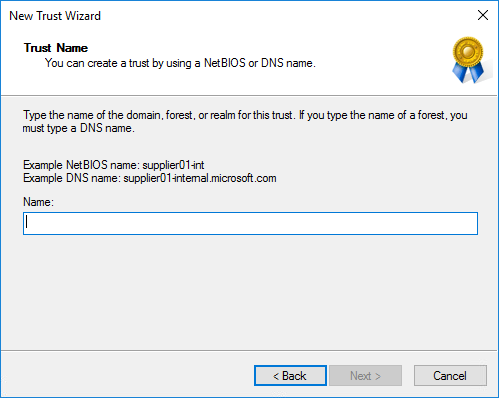
-
For the Trust Type, select Forest trust and click Next.
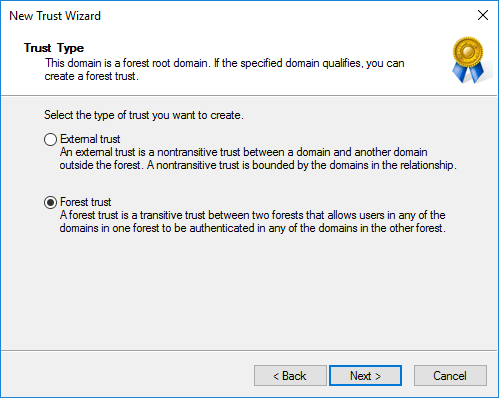
-
Unless you need a two-way trust, select One-way: incoming and click Next.
File Dynamics supports Two-way or One-way: incoming directional trusts.
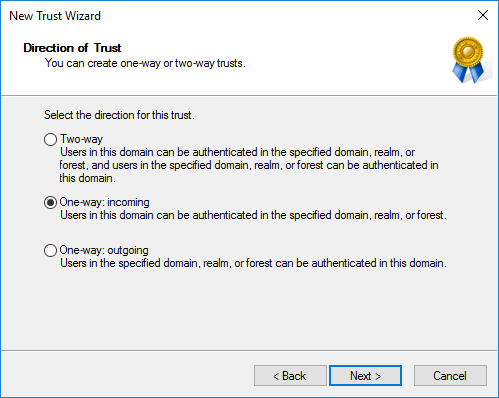
-
(Conditional) If you have the necessary permissions, specify Both this domain and the specified domain and click Next.
Depending on the appropriate permissions that you have as the user you're logged in as, you can create both sides of the trust relationship.
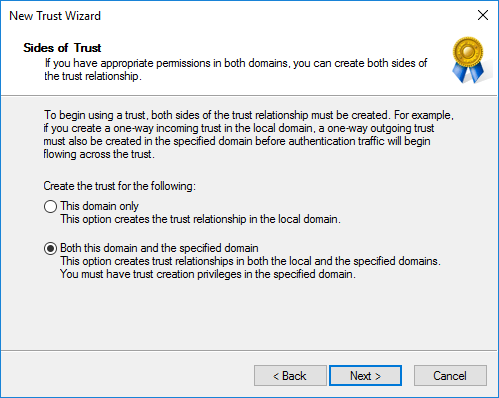
-
Enter credentials for the specified source domain and click Next.
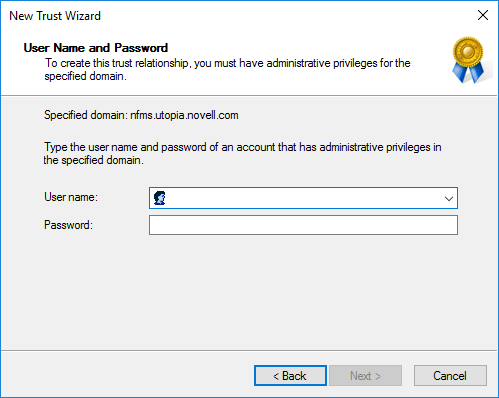
-
Specify Forest-wide authentication and click Next.
File Dynamics requires Forest-wide authentication.
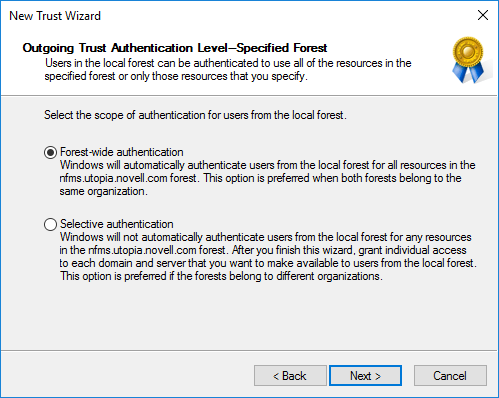
-
Review the selected trust settings. If everything is correct, click Next.
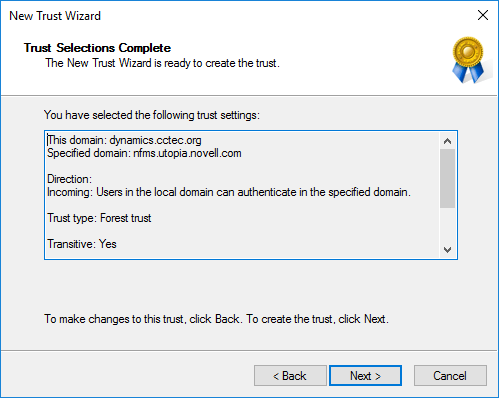
-
Once the trust is successfully created, click Next.
-
To validate the trust, specify Yes, confirm the incoming trust and click Next.
-
View the updated status of changes and click Finish.
-
In the Properties dialog box, view the new Transitive Forest Trust.
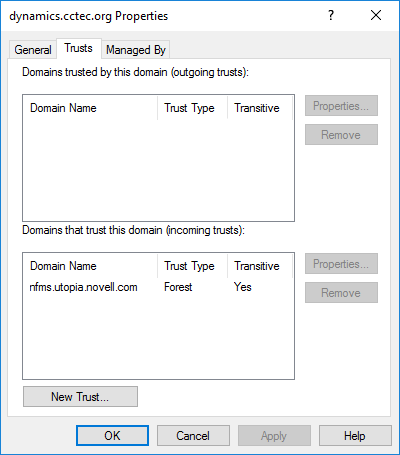
-
In the Properties dialog box, examine the properties of the trust by selecting the trust and clicking Properties.
-
Click OK to close the trust properties dialog box.
-
Click OK to close the domain properties dialog box.
File Dynamics can now be configured to use the trust for Active Directory to Active Directory Cross-Empire Data Migrations.
12.1.7 Agents
File System Agents perform copying, moving, grooming, and vaulting. Phoenix Agents conduct Epoch scanning, data integrity, and data copying and recovery for Epochs. All Agents tasks are done through directives from the Engine. File Dynamics determines which Agent to use based on the task, as well as the target destination of the data or via proxy configuration.
For optimum performance, File System Agents should be installed on all servers with storage managed by File Dynamics. Agents run as a native service on Windows.
The Agent page lets you:
-
Authorize an Agent
-
Verify that Agents are authorized
-
View Agents software versions installed
-
View Agent statistics
-
Remove an Agent
-
Configure a Proxy Agent
The Agent page also indicates:
-
Whether the Agent is capable of being utilized in a Cross-Empire Data Migration
-
Whether the Agent is functioning as a Proxy Agent and for which server and share
Procedures for authorizing an Agent are located in Authorizing the Agents in the Micro Focus File Dynamics 6.5 Installation Guide.
Deleting an Agent
Within the Admin Client, you can delete a deauthorized Agent. Only deauthorized Agents can be deleted. If you want to remove an Agent, you must deauthorize it first.
NOTE:If an Agent is deauthorized and it hasn't successfully sent a heartbeat within 7 days, it will automatically be removed.
Proxy Agents
For storage resources that do not or cannot host an Agent, for example a NAS (Network Attached Storage) device, File Dynamics can utilize an Agent running on another server to perform the copying, moving, grooming, and vaulting on the server or NAS device. In this type of scenario, the Agent is serving as a “Proxy Agent.” Both File System Agents and Phoenix Agents can serve as Proxy Agents.
A Proxy Agent can also be set up to reduce the workload on the Engine. For example, a Proxy Agent can be configured for a server on one side of a WAN environment to move data from one server to another on the same side of the WAN link. This keeps the data from crossing the WAN link only to cross back again.
Configuring an Agent to be a Proxy Agent
-
In the Admin Client, click the Engine tab.
-
Click Agents.
-
From the Configure Proxies drop-down menu, select the Agent type you will be configuring.
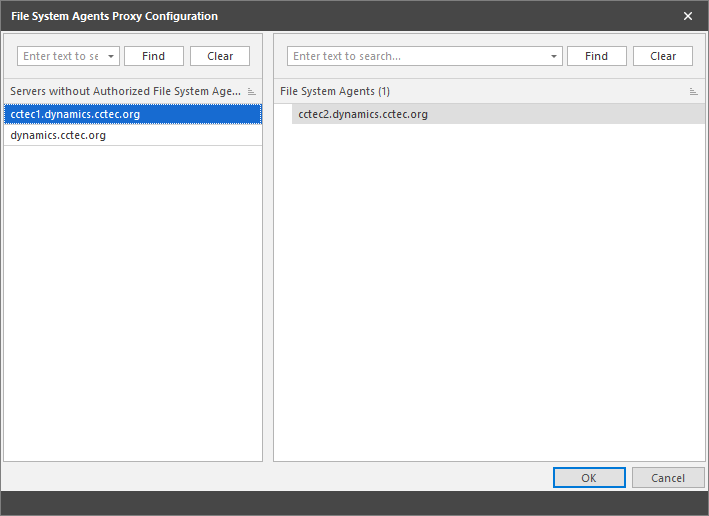
The left pane displays all servers without an authorized Agent. The right displays servers hosting Agents, and consequently, can serve as Proxy Agents.
-
From the left pane, select and drag a listed server to one on the right pane that you want to serve as a Proxy Agent.
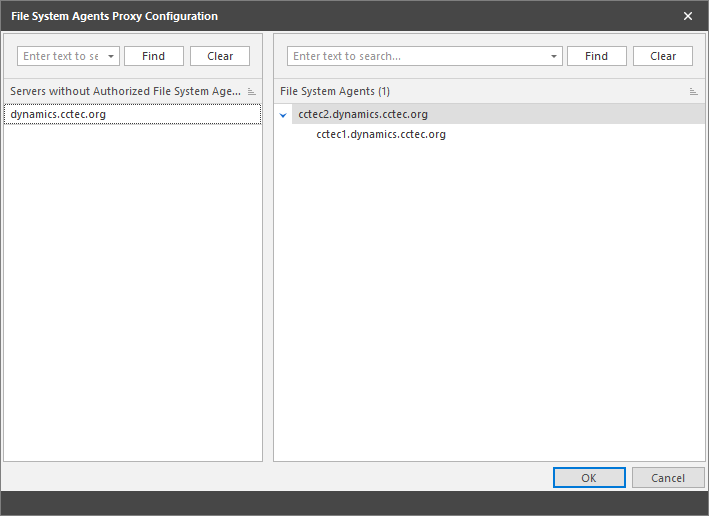
-
Click OK to save the Proxy Agent assignments.
-
Click OK to save and close the proxy setting association.
12.1.8 Event Monitors
The Event Monitor monitors changes to Active Directory based on create, move, rename, and delete events.
You install one Event Monitor per domain, and it can run on a domain controller or a member server. If you install the Event Monitor on a domain controller, the Event Monitor always monitors the local server for changes in the domain. If you install the Event Monitor on a member server, the Event Monitor identifies the closest available domain controller and monitors it for changes in the domain. The Event Monitor runs as a native service on Windows.
In the Event Monitors page, you can:
-
Authorize an Event Monitor
-
Verify that an Event Monitor is authorized
-
View the Event Monitor software version installed
-
View Event Monitor statistics
-
Remove an Event Monitor
The Event Count number indicates the total number of events sent from the Event Monitor to the Engine.
Procedures for authorizing the Event Monitor are located in Authorizing the Event Monitor in the Micro Focus File Dynamics 6.5 Installation Guide.
Deleting an Event Monitor
Within the Admin Client, you can delete a deauthorized Event Monitor. Only deauthorized Event Monitors can be deleted. If you want to remove an Event Monitor, you must deauthorize it first.
12.1.9 Event Scope
Rather than burdening the Event Monitor in observing all events in the Active Directory forest or domain, this feature lets you “scope” the segments of the forest or domain that the Event Monitor will monitor. A scoped segment of the forest or domain might include specific containers or groups.
For procedures on how to use this feature, see Section 4.0, Configure the Event Monitor Scopes. For a complete discussion of the Scope feature, including Include and Exclude behaviors, see Section G.0, Event Monitor Scope.
12.1.10 Check Updates
This page compares the version numbers of File Dynamics components that you have installed with the latest versions available. It also provides links for downloading the latest versions of each of the components.